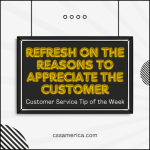
I have a lot of clients that struggle with this question, both at a company/strategic level as well as an individual representative level. When there is an issue that is going to happen, should you tell the customer? This week we’re going to address the question at the company level. Next week, we’ll address the question at the individual employee level.
At the company or strategic level, the discussion usually centers around some change the organization is about to make. Maybe they’re going to test something in operations or in a system or with a service that might have some negative ramifications to the customer. Maybe they’re going to eliminate a perk or benefit that many customers utilize. Maybe they’re going to change a policy or procedure or stop providing a feature that customers enjoy.
So, should that company tell the customer? If the company doesn’t tell the customer, it oftentimes is because they don’t even think about the customer. They are so focused on their project or their product or their process or their promotion that they don’t think about everybody who might be impacted. Sometimes they’re trying to avoid complaints by not drawing attention or awareness to a change some customers might not like.
A way to answer this question at the company level is to keep in mind that problems are created when a customer expects “A” and they get “B”. Also keep in mind, that when a customer brings a problem to the attention of the organization, the customer’s in control of how that conversation goes. However, if the company takes control of that conversation by notifying the customer of what’s going to change, the company has control over what that message is, how it’s delivered, and within what environment that message is sent.
While there is no one pat answer to this question, most organizations in most situations need to tell the customer. They need to be upfront on what’s going to change so that they can maintain some control over how that communication goes with the customer.
Few organizations have failed because they are too proactive, too open, and too honest with their customers.
When deciding whether or not you should tell the customer, lean toward those options which build trust and transparency with your customer.
Signup for FREE Tips! Contact Us More Resources for You Visit Our Home Page























